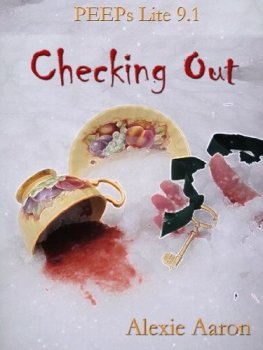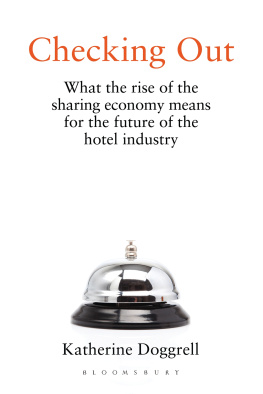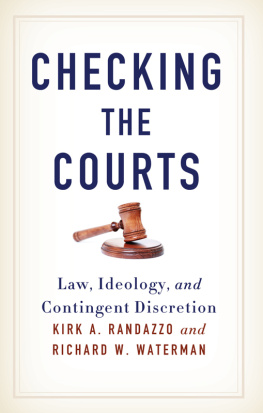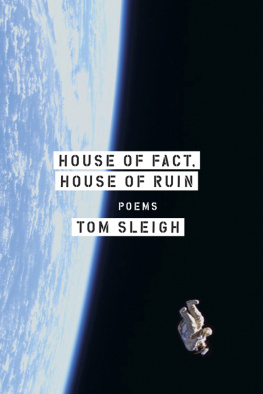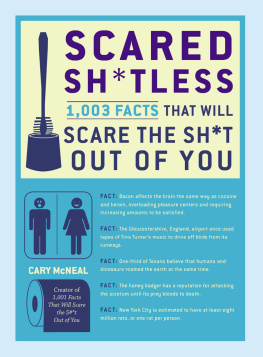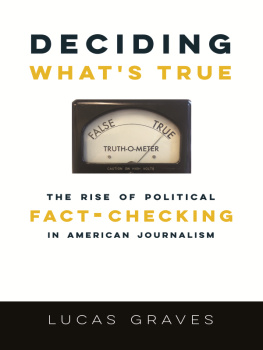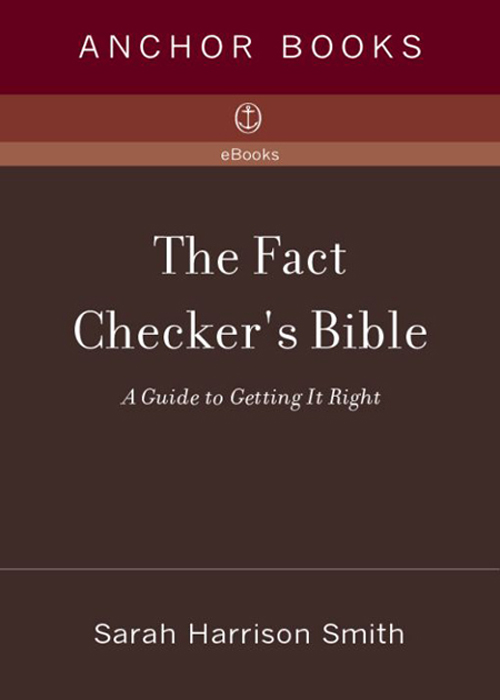

Table of Contents
For Martin Baron and Peter Canby
with admiration and gratitude
Acknowledgments
I owe great thanks to my former colleagues at The New Yorker checking department and my new coworkers at The New York TimesMagazine, from whom I have learned so much.
I must also thank the journalists who have reported on fact-checking in the news, particularly those at the Columbia Journalism Review,Brills Content, and The New York Times.
John Thornton of the Spieler Agency came up with the idea for The Fact Checkers Bible and was extremely helpful throughout the proposal and writing of the book. Alice van Straalen, my editor at Anchor Books, was enormously patient, encouraging, and thoughtful. I am very grateful to them both.
My mother, Marlis Smith, who as a young woman worked at the information bureau of the New York Daily News, helped to care for my infant daughter so that I could have more time to write. My husband, David Yezzi, was supportive in innumerable ways and, as a former head of fact-checking at The New York Observer, was an ideal person to talk to about the issues.
Many people generously discussed their experiences in fact-checking, writing, editing, or the practice of media law. In particular, I would like to thank Linda Amster, Michael Anderson, Greta Austin, Martin Baron, Sandra Baron, Jeffrey Blum, Lois Smith Brady, Patricia Brown, Peter Canby, Chris Carduff, Deirdre Casper, Devereux Chatillon, Susan Choi, Russ Clarkson, Anne Colby, John Cotter, Cynthia Cotts, Amy Davidson, Byron Dobell, Elizabeth Dobell, John Dorfman, Jillian Dunham, Liz Duvall, Emily Eakin, Blake Eskin, Marion Farrier, David Ferguson, Mike Fleming, Nancy Franklin, Jeff Franks, George Freeman, Paul Gallagher, Kevin Goering, Kim Grad, Dade Hayes, Virginia Heffernan, Carol Howard, Dorothy Ingebretson, Esther Kartiganer, Dan Kaufman, Johanna Keller, David Kirkpatrick, David Korzenik, Hilton Kramer, Thomas Kunkel, Mary LaMotte, Michael LaRaque, Bruce Lazarus, William Lin, Sara Lippincott, William Littler, Clark Lombardi, Robert Mac-key, Kee Malesky, Charles Martin, David McCraw, Bill McGeveran, Rene Michael, Annette Miller, Anne Mortimer-Maddox, Eric Nash, Jim Oberman, Cynthia Ozick, Robert Read, Mandy Reilly, Lee Riffaterre, Nandi Rodrigo, Dana Rodriguez, Lesley Rogers, Megan Rosenfield, Betty Satterwhite, Robert Scheffler, Liesl Schillinger, Dan Schlenoff, Ellen Scordato, Allan Siegal, Spencer Smith, Jim Steinblatt, Anne Stringfield, Julie Tate, Jeff Toobin, Calvin Trillin, Ken Tucker, Nola Tully, Robert Walsh, Greg Welch, Av Westin, Eileen Whitfield, Margot Williams, Jane Wulf, Jonathan Zittrain, and the staff of the New York Society Library.
Introduction
Why ls Fact-Checking Necessary?
Depending upon your areas of knowledge, youll be bothered by different sorts of errors in print. You are likely to notice mistakes in a short story set in your hometown, in a profile of a business or a person you know well, in a review of a book youve reador worse, writtenor in a feature about a place or subject youve studied. Some errors are benign and positively enjoyable to anyone they dont malign, and spotting errors can become something of a sport. As Cullen Murphy noted in The Atlantic Monthly, the section newspapers allot to corrections is one of the most entertaining to read. What most readers take away from such columns is not appreciation for the retrospective accuracy but gratitude for the original mistake. (For people who really enjoy a good error, I recommend Kill Duck Before Serving, Linda Amster and Dylan Loeb McClains funny collection of New York Times corrections. The Times established a section for corrections in 1972 and since then has been delighting and horrifying readers with periodic handfuls of howlers.) I admit to feeling a little schadenfreude when I see misidentifications of people and places in photographs. It doesnt seem to matter much most of the time, particularly when the error is obvious. It merely embarrasses the publication and its editors (the latter, for the most part, anonymous to most readers in any case).
Some errors detract more seriously from the reputation of the writer, or at least, his or her credibility in the readers eyes. The jacket copy for Joseph Epsteins book Narcissus Leavesthe Pool compares him to Hazlitt, Mencken, and Montaigne. But on page 145 of this collection of essays, Epstein defines chuffed, a word he says is new to him, as meaning irritated, disgruntled, more than a little displeased. Hes wrong. Merriam-Webster defines chuffed as proud, satisfied. Its a small error. To those readers who notice it, however, it undermines faith in Epsteins erudition. If this one word is defined as opposite to its actual meaning, what else in the essays could be wrong? To my mind, Epstein should have been protected from this embarrassment by his publishers. An editor or fact checker should have taken a moment to check chuffed.
Some writers are intentionally ambiguous about the line between fiction and fact. Theres a virtue to allowing authors to filter reality through their imaginations, and that tempering ought to be respected and permitted. I would argue that blending fiction and fact is fine so long as everyone involved in the production of the work knows which is which and the reader is made aware that hes not reading straight fact. Fact-checking can help to delineate the boundaries between fact and fiction and, of course, ensure that the facts intended to correspond to objective fact are accurate.
The issues are different, however, when the writing in question is reportage. Documenting real events is serious. The most interesting pieces are often the most difficult to confirm, and when checkers are unable to speak directly to sources, much of the burden of verification falls on the author. This always involves some risk. Michael Finkel got away with creating a composite character as the protagonist for his NewYork Times Magazine story Is Youssouf Mal a Slave?, blending the experiences of a number of young men in similar situations into a portrait of one. The photograph the author provided to accompany the piece was identified as being of Youssouf Mal but was, in fact, of a boy named Madou Traor. Other important facts in the story were shown to be incorrect after publication. Finkels conflations and inventions were embarrassing to the Times, particularly because the magazine did attempt to fact check the story. If Finkels reporting had been more reliable, the checking process might not have mattered so much. Finkel had published eight other pieces at the Times without any checking problems. In this case, however, the combination of a newspaper-style policy of not requiring authors to submit their notes and some seemingly insurmountable difficulties in communicating with sources in Mali led to an entire articlenot just a few stray factsslipping into publication without adequate corroboration.
The real trouble with errors, whether they are significant, as in Finkels piece in the Times Magazine, or insubstantial, as in Epsteins essay, is that they cause readers to become cynical. As Sara Lippincott, a former head of fact-checking at TheNew Yorker, once said, A little skepticism... is much to be desired, but if it is fed over and over again with a diet of misinformation, it eventually becomes cynicism, which is a different thing entirely. Then we are turned off. Then we cease to listen to each other at all, and so the journalist is in danger of becoming extinctor ignored, which amounts to the same thing.
Next page

